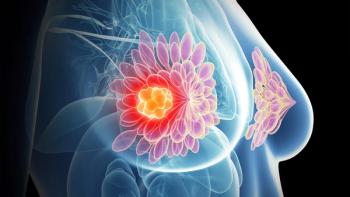
Symptom Burden Analysis Supports Ongoing Posttreatment Analysis for Patients With CRC
Major findings demonstrated that patients with colorectal cancer experienced generally low symptom severity with most symptoms remaining stable or improving following treatment.
To understand patient-reported symptoms and supportive care needs for those with stage II and stage III colorectal cancer (CRC), investigators launched a retrospective population-based cohort study analysis. Major findings demonstrated that patients experienced generally low symptom severity with most symptoms remaining stable or improving following treatment. However, some patients were at an increased risk for more severe symptoms and deterioration over time, according to findings published in the Journal of Clinical Oncology.1
Results from the study showed that patients with stage II or III CRC who had completed at least 2 patient-reported outcome (PRO) measures (N = 303) experienced tiredness (80.5%), pain (50.8%), and poor well-being (50%) most frequently during their treatment. After treatment, these symptoms were reported at a rate of 71.3%, 44.2%, and 62.1%, respectively. Study authors noted that these results were heterogeneous with respect to improvements, stability, or deterioration. The median time between PRO measurements was 174 days (IQR, 132-221).
To conduct their study, investigators collected data from patients with newly diagnosed stage II and stage III CRC using provincial cancer registry administrative data from Alberta, Canada, spanning January 1, 2016, to January 31, 2019. Patients needed to be aged at least 18 years, have received adjuvant treatment, and completed at least 2 PRO surveys.
PROs were collected via the Putting Patients First survey, which included the validated Edmonton Symptom Assessment System revised (ESASr) questionnaire and the Canadian Problem Checklist (CPC). The ESASr is used to screen for common symptoms experienced by patients with cancer; patients rate the severity of their symptoms from 0 to 10, with 0 being an absence of symptoms and 10 being the most severe symptoms. The CPC is a checklist designed to capture the supportive care needs of patients that is made up of 33 items grouped into 7 domains: emotional; social, family, or spiritual; practical; physical; mobility; informational; and nutrition.
To be included in the study, PROs needed to be completed within 3 months after the start of first treatment to qualify for the during treatment period, which included radiation, surgery, and/or adjuvant therapy, and more than 7 months following the start of treatment to qualify for the after-treatment period. PROs were considered complete if at least half of the items were completed. In the event of multiple PROs being available, the 1 closest to the middle of treatment for the during treatment period and the first completed PRO after treatment for the posttreatment period were included. Patients with multiple cancers and those who initiated radiation more than 2 weeks after chemotherapy were excluded from the study.
The median age of patients who were included in the study was 60.0 years (range, 28.0-85.0). Patients either had tumors of the colon (48.8%) or rectum (51.2%). Most patients were men (62.0%), had stage III disease (84.5%), and had a Charlson comorbidity index of 0 (74.9%). Most patients resided in an urban setting (66.3%) and had an income of at least $35,000 (54.5%). Patients did not have comorbidities for the most part; however, 16.8% had diabetes and 6.9% had cardiovascular disease.
Additional findings from the study showed that during chemotherapy, patients experienced drowsiness, nausea, loss of appetite, and breathlessness at a rate of 63.0%, 35.6%, 43.9%, and 31.7%, respectively. After chemotherapy, the respective rates were 52.5%, 25.4%, 30.7%, and 32.3%. ESASr psychologic measures included depression, anxiety, and well-being; during chemotherapy these were present in 33.7%, 39.9%, and 65.7%, respectively, of patients during chemotherapy, and 38.6%, 41.9%, and 62.1% of patients, respectively, after chemotherapy.
Overall, the mean total ESASr score out of a possible 90 points was 15.1 during treatment and 13.1 after treatment (P = .002), with 53.8% of patients have an improvement of at least –1 point, 11.6% having stable score, and 34.7% experiencing a deterioration of at least 1 point. The mean physical subscore was 10.2 out of a possible 60 points during treatment compared with 8.5 after treatment (P < .001). Most patients (51.5%) had an improvement of at least –1 point, 11.9% had stable score, and 36.6% had a deterioration of at least 1 point. The mean psychologic subscores out of a possible 20 points were not significantly different during vs after treatment, at 4.8 and 4.6, respectively.
During chemotherapy, the most severe physical symptoms included tiredness (mean 3.2), drowsiness (mean 2.1), and appetite (mean 1.6). After chemotherapy, these symptoms were scored at a mean of 2.6, 2.1, and 1.0, respectively. Notably, the only statistically significant differences in severity during and after chemotherapy were for tiredness (P < .001) and appetite (P < .001).
In terms of supportive care, 35.0% of patients reported having 0 supportive care needs during treatment, 41.6% of patients reported 1 to 5 supportive care needs during treatment, and 23.4% reported 6 or more during treatment. After treatment, these rates were 43.6%, 36.3%, and 20.1%, respectively.
Investigators found that older age was associated with deterioration of ESASr physical subscore (OR, 1.02; 95% CI, 1.00-1.04). Notably, having stage III disease was protective against deterioration in terms of ESASr total score (OR, 0.46; 95% CI, 0.24-0.89) and ESAS physical subscore (OR, 0.51; 95% CI, 0.27-0.97).
Patients with rectal cancer compared with colon cancer proved to be at risk for deterioration in terms of their total ESASr score (OR, 1.97; 95% CI, 1.19-3.30), ESASr physical score (OR, 2.20; 95% CI, 1.34-3.68), and appetite (OR, 2.93; 95% CI, 1.49-6.05). Additionally, those with a Charlson comorbidity score of 1 or greater were at risk of poorer appetite post treatment compared with those who had a score of 0 (OR, 2.18; 95% CI, 1.08-4.33).
Living in a rural community compared with an urban setting was associated with worsening anxiety after treatment (OR, 2.18; 95% CI, 1.19-4.02). Those in neighborhoods with a mean income of at least $35,000 per year also experienced worsening anxiety after treatment compared with patients living in an area where the mean was less than $35,000 (OR, 1.86; 95% CI, 1.01-3.50).
Investigators noted that the difference in treatment trajectory of patients with colon cancer vs patients with rectal cancer may partially explain the worsening symptom burden in patients with rectal cancer. The also wrote that limitations of the study included its retrospective nature, the use of a generic PRO vs one specific to CRC, and generalizability. Study authors wrote that their findings “underscore the need for ongoing assessment and interventions to address physical and psychologic symptoms, and supportive care needs in patients with CRC both during and after treatment.”
Reference
Cuthbert CA, O'Sullivan DE, Boyne DJ, et al. Patient-reported symptom burden and supportive care needs of patients with stage II-III colorectal cancer during and after adjuvant systemic treatment: a real-world evidence study. JCO Oncol Pract. 2023;19(3):e377-e388. doi:10.1200/OP.22.00462
Newsletter
Knowledge is power. Don’t miss the most recent breakthroughs in cancer care.














































































